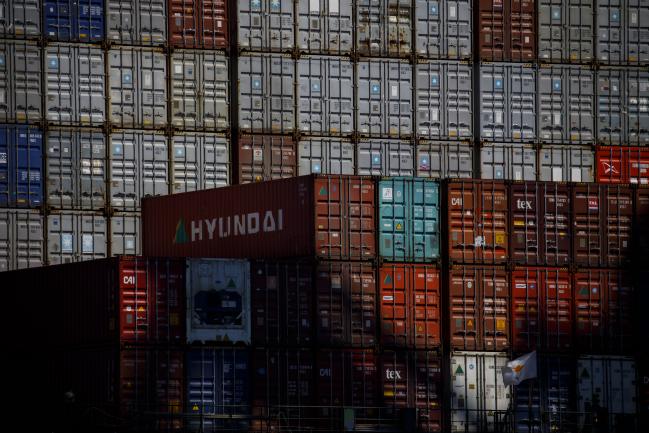(Bloomberg) -- The U.S. and China indicated they’re willing to negotiate on escalating frictions, helping to ease fears among investors that a tit-for-tat trade dispute could derail the strongest global expansion in years.
The White House’s National Economic Council Director Larry Kudlow spent much of the day Wednesday trying to calm markets after the two countries announced tariffs, and said they still have time work out their differences.
“Remember, none of the tariffs have been put in place yet. These are all proposals,” he said in a brief interview, without specifying if talks are planned or how they’d take place. “We’re putting it out for comment. There’s at least two months before any actions are taken. China by the way did not enact the tariffs.”
China’s ambassador to the U.S., Cui Tiankai, also said his first choice would be to consult the U.S. over trade. “Negotiations would still be our preference, but it takes two to tango,” he said. “We’ll always stand for consultation and negotiation, but if others do things in the wrong direction, we’ll have to respond.”
The comments came after China early on Wednesday said it would levy an additional 25 percent tariff on about $50 billion of U.S. imports. The move matched the scale of proposed U.S. tariffs announced the previous day. The U.S. is allowing 60 days for public feedback and hasn’t specified when the tariffs would take effect, leaving a window open for talks.
U.S. stocks opened sharply lower on Wednesday, but reversed course and ended the day higher as investors speculated the spat wouldn’t spiral out of control. The Stoxx Europe 600 Index jumped 1.5 percent as of 8:12 a.m. London time while futures on the S&P 500 Index rose 0.5 percent to the highest in more than two weeks.
President Donald Trump also downplayed the skirmish, saying on Twitter that “we are not in a trade war with China, that war was lost many years ago by the foolish, or incompetent, people who represented the U.S.”
Trump also tweeted that “when you’re already $500 Billion DOWN, you can’t lose,” in a possible reference to America’s trade deficit with China. Figures from the U.S. Commerce Department put last year’s trade gap with the Asian nation at $337 billion.
The Trump administration’s latest offensive is a response to alleged infringements of intellectual property in China. The U.S. is targeting high-tech sectors that Beijing sees as the future for its economy.
While the China retaliation was more “belligerent” than expected, Beijing probably wants to de-escalate tensions by underscoring what’s at stake for both sides, Oxford Economics director of global macro strategy, Gaurav Saroliya, said in a research note. “Negotiations will probably lead to less disruptive outcomes for both sides,” Saroliya wrote.
In a statement following the U.S. release of details on its China tariffs, Treasury Secretary Steven Mnuchin said the administration “will continue to engage in discussions with China to address these issues of reciprocal trade.”
QuickTake: Trump Wanted a Trade War. Here’s What One Looks Like
|
For more on the U.S.-China tariffs dispute China’s planned tariffs:Read more on the potential impact on Boeing (NYSE:BA) What a 25% tariff on soybeans means for U.S. producers U.S. planned tariffs: |
Beijing’s proposed targets strike at the core of commercial relations between the two countries, and at some of the most politically sensitive goods in core Trump constituencies. For example, China is the world’s largest soybean importer and biggest buyer of U.S. soybeans in trade worth about $14 billion last year. Farming states were also among Trump’s staunchest supports in the election.
The implementation of China’s tariffs depends on the outcome of bilateral negotiations, as well as U.S. decisions, Deputy Finance Minister Zhu Guangyao told reporters after a news conference in Beijing. “We believe both countries have the ability and wisdom to address the problem,” Zhu said.
Stocks to Watch After Trump Announces Proposed China Tariffs
Industries including aerospace, information and communications technology, robotics and machinery were among those targeted by the U.S. Trade Representative on Tuesday. The agency said it chose products to minimize the impact on the U.S. economy and consumers.
In addition to advanced technologies such as communication satellites, the U.S. list includes items ranging from various types of steel to television components, medical devices, dishwashers, snow blowers and even flame throwers. The 25 percent tariffs come on top of any existing levies.
“The U.S. list suggests that the government is targeting the ‘Made in China 2025’ initiative, while China’s retaliation intends to bring Americans back to the negotiation table,” Zhou Hao, an economist at Commerzbank AG (DE:CBKG) in Singapore, said in an email.
|
What our analysts say ... “The U.S. proposal on tariffs aims to hit China’s industrial ambitions without hurting U.S. consumers,” said Tom Orlik, chief Asia economist at Bloomberg Economics in Beijing. “On both objectives, it will likely fall short. In sum -- we think the macro impact will be limited and the strategic objectives difficult to achieve.”“This is far from the worst-case scenario feared by retailers and consumer groups,” according to Bloomberg Intelligence trade-policy analyst Caitlin Webber. “The consumer goods and technology that the U.S. is most reliant on China to provide -- like toys, shoes, video game consoles, mobile phones and computers -- were all left off this list. These omissions will likely avoid a major popular outcry.” |
China’s Made in China 2025 plan was announced in 2015, and highlighted 10 sectors for support on the way to China becoming an advanced manufacturing power, from information technology to robotics and aerospace. China also has a separate development strategy for artificial intelligence, published last year.
“The current tariff measures from both parties are very unlikely to be implemented,” said Ren Qing, a partner at Global Law in Beijing who has advised the Chinese government on its response to the intellectual-property investigation. “People from American industries may exert pressure on the U.S. government and influence final policy implementation.”
(Updates with markets in the sixth paragraph.)
